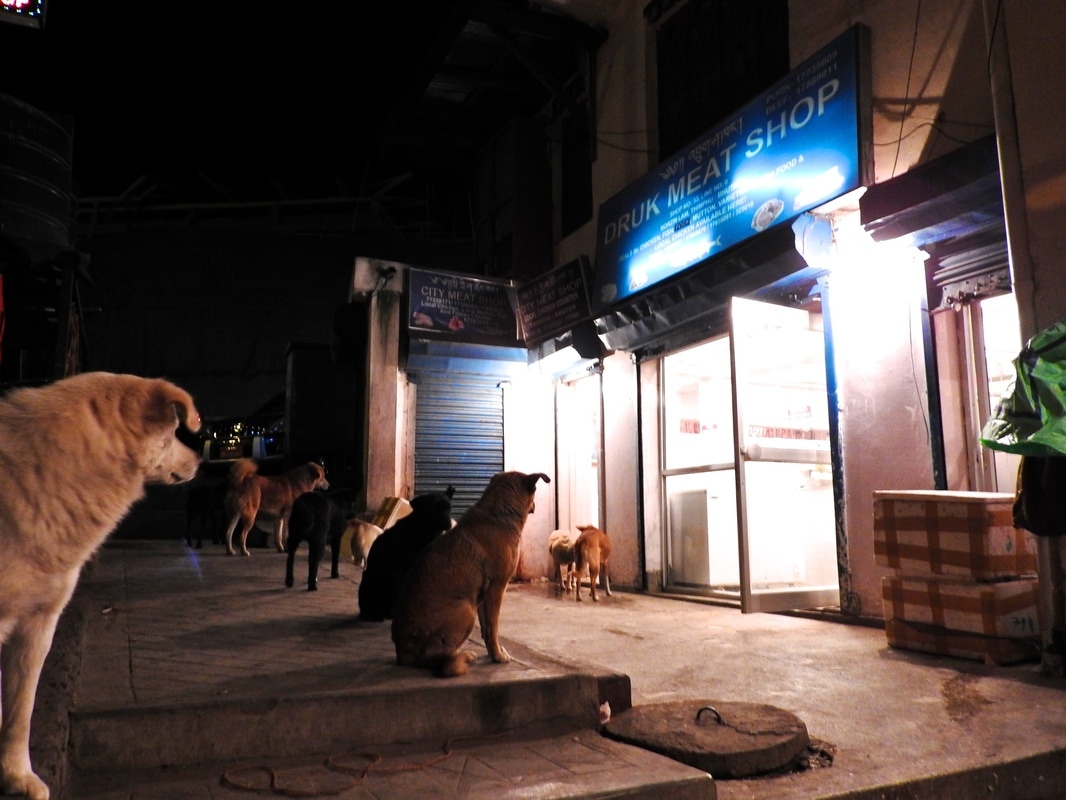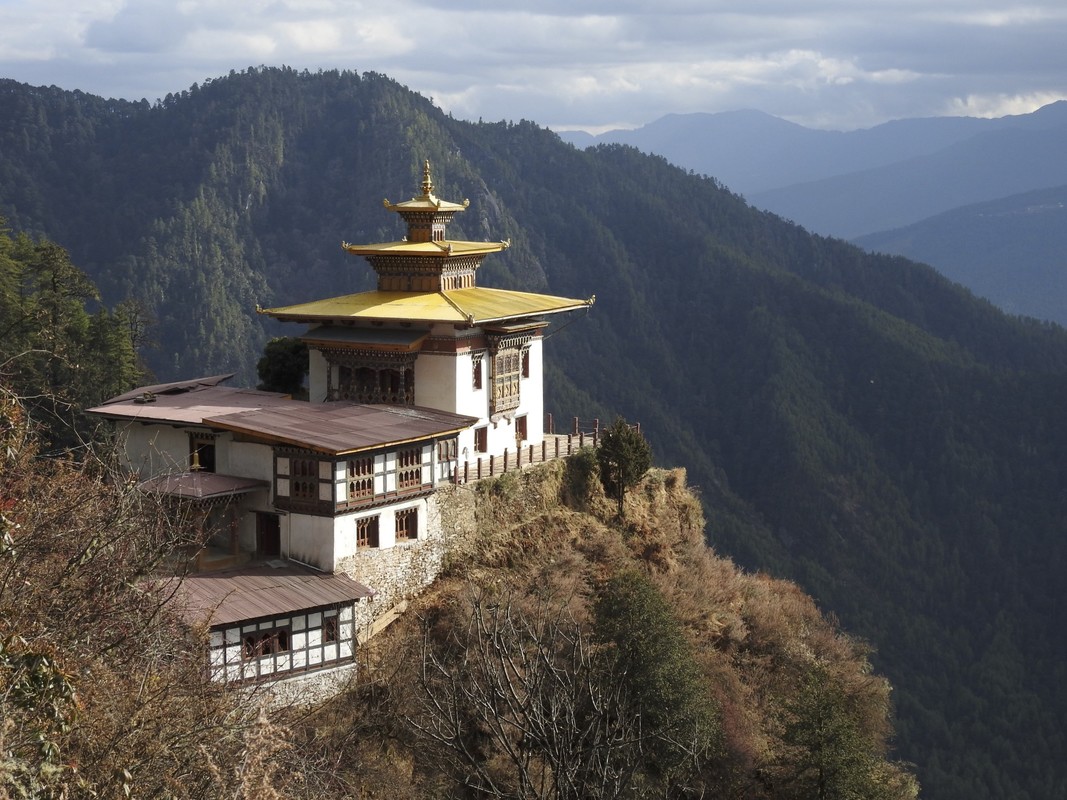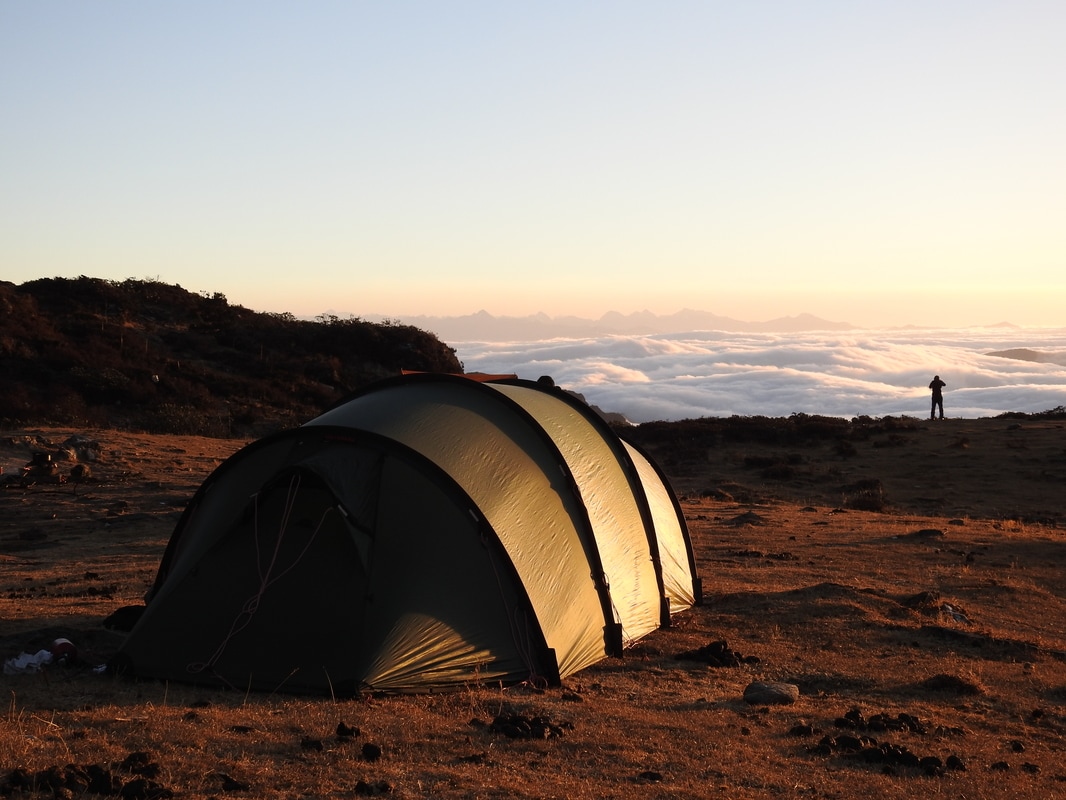 Turns out we weren't the only hungry ones in Thimphu.
Turns out we weren't the only hungry ones in Thimphu.
We spent most of New Year’s Eve cycling from the lovely Haa Valley Homestay to Thimphu. Heading downstream, the road actually brought us higher and higher up as the valley narrowed. This road has not yet been subjected to widening construction, so it was a really pleasant ride with sweeping views of rural homesteads dispersed across rolling hills. We descended abruptly to Chuzom, a river confluence and road junction point, then rode the “busy” road back to Thimphu mostly in the dark.
We celebrated NYE by taking a cold shower (not by choice) at our usual Thimphu base, Hotel Sambauv, then headed out to our favorite restaurant, A La Carte, for our favorite food in the city: amazingly authentic tasting Thai papaya salad with grilled chicken, and a “KFC” chicken burger, much better than the real thing. The place was already packed with partiers dressed in their best ensembles, knee-high boots, 80s ripped jeans, purple faux fur coats, and the like. As for us, we splurged out on some $1.25 drink specials, hot apple cider whiskey and butter-fried ara, of which the latter tasted like a harsh egg nog when using a bit of imagination. Then, as our tradition dictates, we were in bed before midnight, listening to fireworks and a surge of general revelry around that one very special minute.
Our arrival in Thimphu marked the end of our concrete plans for the rest of winter break, so we had to put in some time figuring out the logistics of, well, the entire month of January. We met with our friends at Bhutan Swallowtail who were a great source of knowledge and advice, of course, being that they own a travel company and all. Slowly, and with a few investigatory phone calls and follow ups to those communications, a somewhat confirmed itinerary began to take shape.
We celebrated NYE by taking a cold shower (not by choice) at our usual Thimphu base, Hotel Sambauv, then headed out to our favorite restaurant, A La Carte, for our favorite food in the city: amazingly authentic tasting Thai papaya salad with grilled chicken, and a “KFC” chicken burger, much better than the real thing. The place was already packed with partiers dressed in their best ensembles, knee-high boots, 80s ripped jeans, purple faux fur coats, and the like. As for us, we splurged out on some $1.25 drink specials, hot apple cider whiskey and butter-fried ara, of which the latter tasted like a harsh egg nog when using a bit of imagination. Then, as our tradition dictates, we were in bed before midnight, listening to fireworks and a surge of general revelry around that one very special minute.
Our arrival in Thimphu marked the end of our concrete plans for the rest of winter break, so we had to put in some time figuring out the logistics of, well, the entire month of January. We met with our friends at Bhutan Swallowtail who were a great source of knowledge and advice, of course, being that they own a travel company and all. Slowly, and with a few investigatory phone calls and follow ups to those communications, a somewhat confirmed itinerary began to take shape.
Simultaneously, I took advantage of the down time in Thimphu to get up close and personal with Bhutan’s nationalized health care system. It had been several years since I had a thyroid function test to ensure I was on the proper dose of medication for my hypothyroidism. While traveling in Asia, I could walk in to any pharmacy and get the prescription medication for a couple of dollars, so there was little incentive to seek out a doctor after leaving the States.
Upon arriving at the Jigme Dorji Wangchuck National Referral Hospital, I had no idea where to begin the process of getting a blood test, so we walked in to the Emergency Department and were advised to go to “Old Building 1,2,3,4,5”. We asked passersby until we found the Old Building, and then deduced that I needed a numbered call ticket to queue outside of either door 1,2,3,4, or 5. After a short wait, my number came up and I entered door three, not sure what should happen behind it. I had barely uttered hypothyroidism and blood test before the “generalist” doctor had written up a lab order, kindly but efficiently instructing me to go to the lab the next morning because it would already be closed for the day. We decided it would be a good idea to preview the lab’s location and found it in the New Building. The door was still open and we noticed a technician drawing a patient’s blood, so I simply walked in and sat down at a sampling station. We would have to come back the next morning for results though, which we did, queuing in a long but fast-moving line at a little window in the outdoor courtyard of the New Building. After receiving my print out of the test results, we hustled back inside to the window that gives out numbered call tickets to visit the “specialists” upstairs. This is where the real waiting began. After a few hours of sitting in the hallway, my number was finally coming up, so I huddled near the door along with a few other numbers ahead of and behind me, as custom appeared to require.
The doctor competently reviewed my test results, but was a bit dismayed that she could not reference my medical records in a hand written composition notebook like the other Bhutanese patients carried. I explained that my medical records were kept in my health care provider’s computer system in the US and assured her that I did not have a very interesting medical history. She wrote a prescription for the same dosage of levothyroxine that I had been self-medicating with, and a lab order for a whole slew of blood tests including liver and kidney function, glucose, electrolytes, and cholesterol. I first had to go next door to get a blood pressure check, then I was free to take my prescription to the pharmacy in exchange for a numbered ticket. The order was filled quite quickly and I received my pills in an unlabeled plastic baggie.
The next morning, we walked to the hospital for the fourth time (one time was a futile attempt when we didn’t realize it was closed for a national holiday), this time confident that we knew the drill. I got the follow up blood test and was told I could pick up the results between 1 and 2pm. When we returned in the afternoon, the print out was indeed ready, but the specialists were already gone. According to a bystander who noticed us looking around in confusion, once a doctor reaches 60, they stop seeing patients for the day. We weren’t terribly upset by this since all of my values fell within the normal range and I had done my own research regarding what each test signifies.
I left the hospital having paid nary a ngultrum, nor owing any, only having spent a decent amount of time there over the course of three days. I received reliable services and quality care even if the process was initially a bit confusing for an outsider. Ultimately, it was fascinating to participate in a system of health care so different from the US. At least for my scenario of non-urgent preventative care, I certainly preferred the investment of time over money. By shifting more of the responsibility and legwork to the patients, the hospital was able to operate efficiently while still accommodating all the people seeking medical assistance. Seemingly, no one is turned away because they cannot pay, because they are uninsured, or because they could not get an appointment. They have to wait their turn with patience, they have to keep track of their own medical history, they have to run around to different windows in different locations, but this system allows lab results to be available in a matter of hours and specialists to consult at least 60 patients per day. Could you imagine a doctor in the US with 60 appointments in a single day? That said, Matt and I wondered if we would have a similar reaction with a more complicated and/or time-sensitive medical condition. We have the privilege of paying for privatized health care if we need it, but most Bhutanese could not.
By then, we were ready to move on from Thimphu. Each time we are there, we always have the best intentions of doing fun stuff like day hikes, visiting local temples, and even a few museums. Yet somehow, running errands, shopping, eating non-Bhutanese food, and sorting gear always takes precedence. This time was no different, but it was essential for the success of the rest of our journey back to Bumthang.
Upon arriving at the Jigme Dorji Wangchuck National Referral Hospital, I had no idea where to begin the process of getting a blood test, so we walked in to the Emergency Department and were advised to go to “Old Building 1,2,3,4,5”. We asked passersby until we found the Old Building, and then deduced that I needed a numbered call ticket to queue outside of either door 1,2,3,4, or 5. After a short wait, my number came up and I entered door three, not sure what should happen behind it. I had barely uttered hypothyroidism and blood test before the “generalist” doctor had written up a lab order, kindly but efficiently instructing me to go to the lab the next morning because it would already be closed for the day. We decided it would be a good idea to preview the lab’s location and found it in the New Building. The door was still open and we noticed a technician drawing a patient’s blood, so I simply walked in and sat down at a sampling station. We would have to come back the next morning for results though, which we did, queuing in a long but fast-moving line at a little window in the outdoor courtyard of the New Building. After receiving my print out of the test results, we hustled back inside to the window that gives out numbered call tickets to visit the “specialists” upstairs. This is where the real waiting began. After a few hours of sitting in the hallway, my number was finally coming up, so I huddled near the door along with a few other numbers ahead of and behind me, as custom appeared to require.
The doctor competently reviewed my test results, but was a bit dismayed that she could not reference my medical records in a hand written composition notebook like the other Bhutanese patients carried. I explained that my medical records were kept in my health care provider’s computer system in the US and assured her that I did not have a very interesting medical history. She wrote a prescription for the same dosage of levothyroxine that I had been self-medicating with, and a lab order for a whole slew of blood tests including liver and kidney function, glucose, electrolytes, and cholesterol. I first had to go next door to get a blood pressure check, then I was free to take my prescription to the pharmacy in exchange for a numbered ticket. The order was filled quite quickly and I received my pills in an unlabeled plastic baggie.
The next morning, we walked to the hospital for the fourth time (one time was a futile attempt when we didn’t realize it was closed for a national holiday), this time confident that we knew the drill. I got the follow up blood test and was told I could pick up the results between 1 and 2pm. When we returned in the afternoon, the print out was indeed ready, but the specialists were already gone. According to a bystander who noticed us looking around in confusion, once a doctor reaches 60, they stop seeing patients for the day. We weren’t terribly upset by this since all of my values fell within the normal range and I had done my own research regarding what each test signifies.
I left the hospital having paid nary a ngultrum, nor owing any, only having spent a decent amount of time there over the course of three days. I received reliable services and quality care even if the process was initially a bit confusing for an outsider. Ultimately, it was fascinating to participate in a system of health care so different from the US. At least for my scenario of non-urgent preventative care, I certainly preferred the investment of time over money. By shifting more of the responsibility and legwork to the patients, the hospital was able to operate efficiently while still accommodating all the people seeking medical assistance. Seemingly, no one is turned away because they cannot pay, because they are uninsured, or because they could not get an appointment. They have to wait their turn with patience, they have to keep track of their own medical history, they have to run around to different windows in different locations, but this system allows lab results to be available in a matter of hours and specialists to consult at least 60 patients per day. Could you imagine a doctor in the US with 60 appointments in a single day? That said, Matt and I wondered if we would have a similar reaction with a more complicated and/or time-sensitive medical condition. We have the privilege of paying for privatized health care if we need it, but most Bhutanese could not.
By then, we were ready to move on from Thimphu. Each time we are there, we always have the best intentions of doing fun stuff like day hikes, visiting local temples, and even a few museums. Yet somehow, running errands, shopping, eating non-Bhutanese food, and sorting gear always takes precedence. This time was no different, but it was essential for the success of the rest of our journey back to Bumthang.



